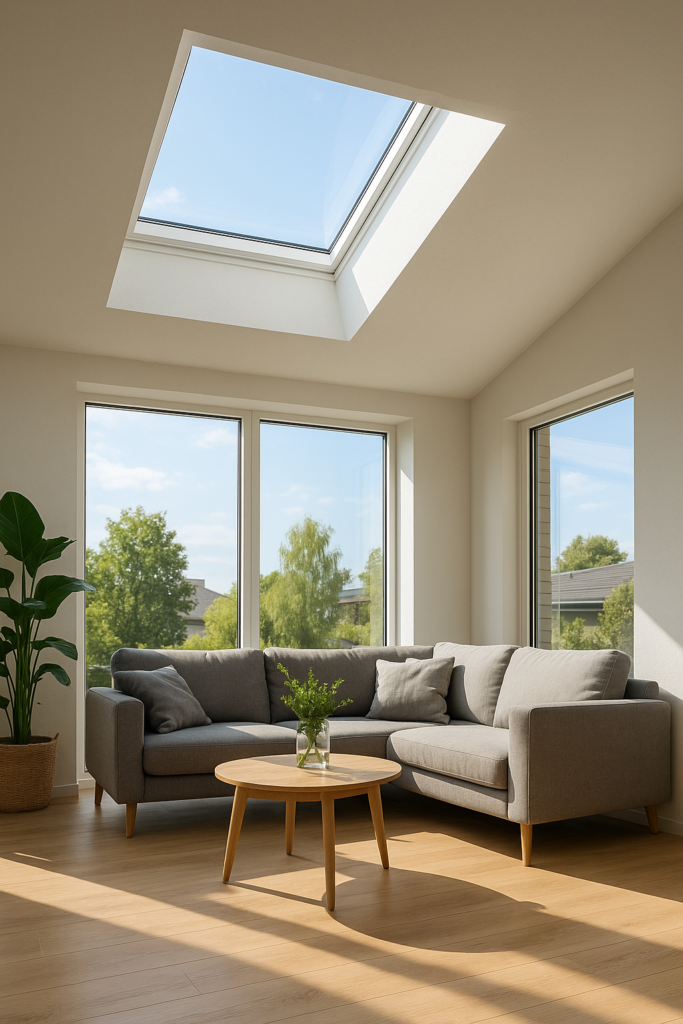Skylights have become a defining feature in modern residential and commercial architecture. They transform spaces by bringing in natural daylight, opening interiors to the sky, and creating bright, uplifting environments. However, skylights also face unique challenges: excessive solar heat in summer, heat loss in winter, UV exposure, and condensation.
The solution that balances beauty with performance is glass low E. Known for its energy efficiency, UV protection, and comfort-enhancing properties, low-emissivity glass is the ideal glazing choice for skylights. This article explores why glass low E should be chosen for skylight use, highlighting its benefits, applications, and long-term value.
What Is Glass Low E?
Glass low E—short for low-emissivity glass—is manufactured with a microscopically thin, transparent metallic coating that reduces infrared and ultraviolet light transmission. It allows high levels of visible light while reflecting heat energy back to its source.
- Winter: Retains indoor heat by reflecting infrared radiation.
- Summer: Blocks solar heat gain while maintaining brightness.
- Year-round: Protects interiors from UV rays while ensuring clarity.
This makes glass low E a performance-driven glazing material that is especially effective in overhead applications like skylights.
Why Skylights Need Glass Low E
1. Managing Solar Heat Gain
Skylights face direct sun exposure, often for several hours a day. Standard glass allows excessive heat, leading to overheating. Glass low E reduces solar heat gain, ensuring spaces stay comfortable.
2. Preventing Heat Loss
Because skylights are positioned at the roof, they are vulnerable to heat escaping during winter. Low-E coatings act as an insulating barrier, improving U-values and cutting heat loss by up to 50%.
3. Blocking UV Radiation
Skylights bring in abundant light, but also harmful UV rays. Glass low E blocks up to 99% of UV radiation, protecting occupants and interior furnishings from fading and damage.
4. Reducing Condensation
Condensation often forms on skylights due to temperature differences. Low-E coatings maintain warmer internal glass surfaces, reducing condensation and mold risk.
5. Enhancing Comfort and Well-Being
By controlling temperature swings, glare, and drafts, skylights with glass low E create healthier, more comfortable environments. Natural daylight improves mood, productivity, and quality of life without the drawbacks of inefficient glass.
Key Benefits of Glass Low E in Skylight Applications
- Energy Efficiency: Saves heating and cooling costs year-round.
- Consistent Temperatures: Prevents hot and cold spots beneath skylights.
- UV Protection: Shields furniture, floors, and artwork from fading.
- Clear Views: Reduces glare without compromising brightness.
- Environmental Impact: Cuts carbon emissions by lowering energy demand.
- Design Flexibility: Available in multiple tints and coatings for modern architectural aesthetics.
Technical Performance for Skylights
When evaluating glass low E for skylights, these metrics matter most:
- U-Value: Lower values indicate better insulation.
- Solar Heat Gain Coefficient (SHGC): Lower values improve solar control.
- Visible Light Transmittance (VLT): Higher values preserve daylight quality.
- Emissivity: Lower emissivity means better reflection of heat energy.
By balancing these properties, homeowners and architects can tailor skylight glazing to their climate and design needs.
Residential Skylight Applications
In modern homes, glass low E skylights are increasingly popular for:
- Living rooms and kitchens: Bringing in natural light without overheating.
- Hallways and staircases: Illuminating transitional spaces.
- Bathrooms: Maintaining privacy with coated or tinted Low-E options.
- Lofts and attics: Transforming formerly dark spaces into livable rooms.
Learn more about residential uses in Where Is Glass Low E Most Used in Modern Housing?.
Commercial Skylight Applications
In offices, malls, airports, and atriums, skylights create open, inviting interiors. But in such large-scale applications, energy performance is critical.
- Reduced cooling loads: Vital for large spaces under direct sun.
- Improved occupant comfort: Prevents glare and temperature extremes.
- Durability: Low-E tempered or laminated skylight glass provides safety and longevity.
For related architectural design choices, see What Makes Glass Low E Ideal for Tall Glass Facades?.
Safety Considerations: Laminated and Tempered Skylight Glass
Skylights must not only perform thermally but also ensure occupant safety. Glass low E can be combined with:
- Tempered glass: Increases strength and prevents dangerous shards. Learn more in What Role Does Glass Low E Tempered Play in Design?.
- Laminated glass: Holds together upon breakage, improving acoustic performance and security. See Why is Glass Low E Laminated Used in Safer Glazing?.
These combinations make skylights both energy-efficient and impact-resistant.
Handling and Installation of Skylight Glass
Transporting and installing skylight panels—often large and heavy—requires care and specialized equipment.
- Use advanced miter clamps to move and install skylight glass safely.
- Apply sustainable stone transport practices to minimize risks and waste during delivery.
This ensures both safety on-site and protection of high-performance coatings.
Environmental Value of Low-E Skylights
Choosing glass low E for skylights is not only about comfort—it’s also about sustainability:
- Lower carbon footprint: Reduced reliance on HVAC systems.
- Daylighting strategies: Brighter interiors cut artificial lighting needs.
- Long-term performance: Durable coatings extend lifespan, reducing replacements.
Sustainable construction practices extend to outdoor environments too. See Define Landscape Concepts in Modern Architecture for complementary eco-friendly design approaches.
Considerations When Selecting Skylight Low-E Glass
- Climate: Choose coatings tailored for hot, cold, or mixed climates.
- Glazing options: Double or triple glazing with gas fills enhances performance.
- Frame materials: Proper framing minimizes thermal bridging.
- Orientation: South-facing skylights need stronger solar control coatings.
- Professional installation: Ensures optimal sealing and energy performance.
Conclusion
Glass low E is the ideal glazing solution for skylights, combining the beauty of natural daylight with advanced performance benefits. It addresses the main challenges of skylight design—solar heat gain, heat loss, UV protection, condensation, and safety—while ensuring year-round comfort and energy efficiency.
Whether in a cozy residential loft or a grand commercial atrium, skylights with low-E coatings provide bright, healthy, and sustainable interiors. When paired with proper handling and installation practices, they offer long-lasting value that enhances both architecture and occupant well-being.
By choosing glass low E for skylight use, homeowners and architects make a future-ready investment in efficiency, sustainability, and comfort.

